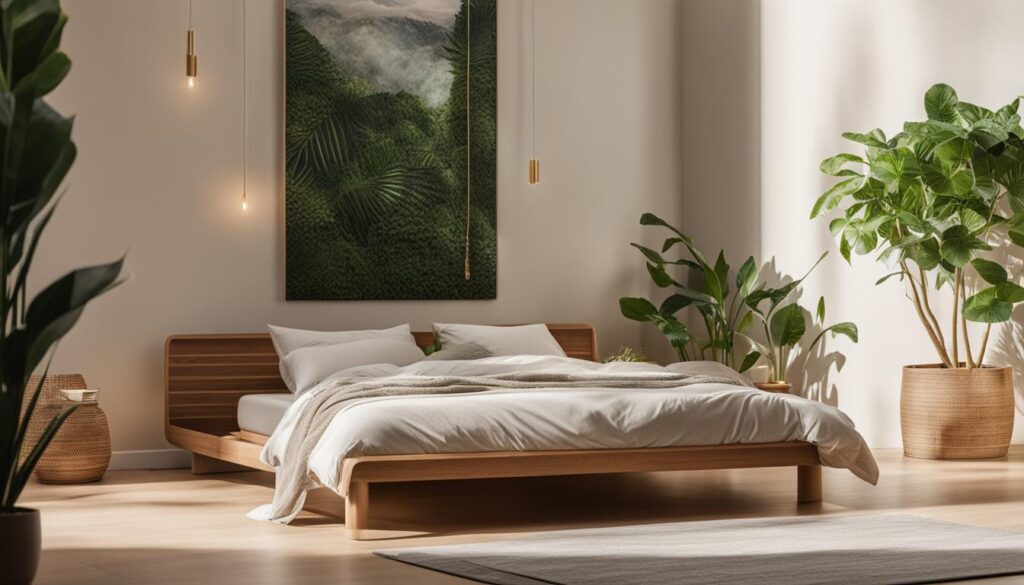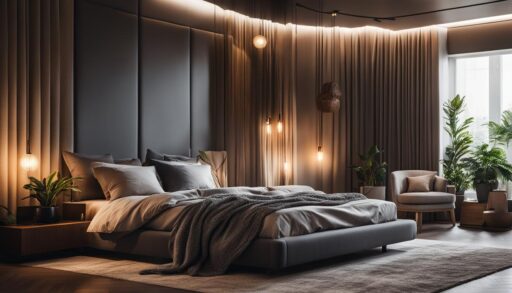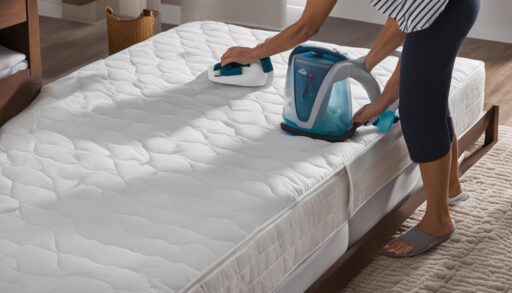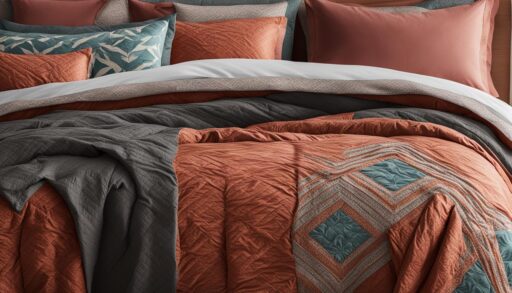Bed Frame Materials and Styles

Your bed frame is not just a piece of furniture; it is a part of your sustainable lifestyle. This comprehensive guide will help you navigate the world of sustainable bed frames and materials. We will explore the different types of bed frame materials, including bamboo, sustainable wood, and recycled materials. Additionally, we will discuss the importance of non-toxic materials and chemical-free options for your bed frame. Finally, we will highlight top brands and retailers that offer eco-friendly bed frames.
Key Takeaways:
- Choose sustainable bed frame materials like bamboo, sustainable wood, and recycled materials.
- Consider non-toxic materials and chemical-free options for better indoor air quality.
- Look for eco-friendly certifications like Greenguard, GOTS, and OEKO-TEX when selecting a bed frame.
- Top brands and retailers like Thuma, Avocado Green Mattress, and Nest Bedding offer sustainable bed frames.
- Complete your sustainable bedroom with eco-friendly bedding made from organic cotton, hemp, or eucalyptus fibers.
Eco-Friendly Bed Frame Materials
Bamboo bed frames have gained popularity in recent years due to their renewable nature and minimal environmental impact. Bamboo is a fast-growing and highly sustainable material, making it an excellent choice for eco-conscious consumers. Not only is bamboo easy to replenish, but it also possesses natural properties that make it resistant to pests and fungi, reducing the need for harmful pesticides and chemicals.
In addition to bamboo, sustainable wood sources are another eco-friendly option for bed frames. Look for bed frames made from wood certified by the Forest Stewardship Council (FSC). The FSC certification ensures that the wood used in the bed frames comes from responsibly managed forests, where trees are replanted or allowed to regenerate naturally. By choosing bed frames made from sustainable wood sources, you are contributing to the preservation of forests and the protection of biodiversity.
Recycled materials, such as steel and plastic, can also be used to create environmentally friendly bed frames. These materials reduce the demand for new raw materials and help divert waste from landfills. By opting for bed frames made from recycled materials, you are contributing to the reduction of resource consumption and the promotion of a circular economy.
Eco-Friendly Bed Frame Materials Comparison
| Material | Advantages | Disadvantages |
|---|---|---|
| Bamboo | Natural, renewable, and resistant to pests and fungi | May require additional treatment for durability |
| Sustainable Wood | Responsible sourcing, supports forest conservation | May be more expensive than other options |
| Recycled Materials | Reduces resource consumption, diverts waste from landfills | Availability and design options may vary |
In addition to sustainable materials, it is important to consider the use of non-toxic materials in bed frames. Many conventional bed frames are made with materials that can release harmful chemicals into the air, negatively impacting indoor air quality. Look for bed frames that are free from formaldehyde, volatile organic compounds (VOCs), and other toxic substances. Opting for non-toxic bed frames creates a healthier sleep environment and reduces your exposure to potentially harmful chemicals.
By choosing eco-friendly bed frame materials, you can sleep soundly knowing that you are making a positive impact on the environment and your health.
Third-Party Certifications And Eco Labels For Eco-Friendly Bed Frames
When choosing an eco-friendly bed frame, it’s important to look for third-party certifications and eco labels that guarantee sustainability and environmental responsibility. These certifications provide valuable information about the materials used and the manufacturing processes involved. They also ensure that the bed frames meet specific standards and regulations. Here are three important certifications to consider:
Greenguard Certification
The Greenguard Certification is a widely recognized and trusted certification for indoor air quality. It ensures that bed frames and other products meet strict chemical emissions limits, promoting healthier indoor environments. With a Greenguard certified bed frame, you can rest assured that it won’t release harmful chemicals or contribute to poor air quality in your bedroom.
Global Organic Textile Standard (GOTS)
GOTS is a leading international standard for organic textiles. This certification guarantees that bed frames are made using environmentally healthy and socially responsible methods. GOTS-certified bed frames are free from harmful substances, such as pesticides and chemicals, and are made with organic materials. By choosing a GOTS-certified bed frame, you are supporting sustainable farming practices and protecting the environment.
OEKO-TEX Standard 100
The OEKO-TEX Standard 100 is a comprehensive certification for textiles, including bed frames. It tests for harmful substances in the materials, ensuring that bed frames are harmless for human health. OEKO-TEX certified bed frames are free from substances that may cause allergies or other health issues. By choosing an OEKO-TEX certified bed frame, you can sleep peacefully knowing that it meets strict safety standards.
By looking for these certifications, you can make more informed decisions when purchasing eco-friendly bed frames. These certifications are a testament to the commitment of manufacturers towards sustainability and environmental responsibility.

Top Brands And Retailers
When it comes to finding the perfect eco-friendly bed frame, there are several top brands and retailers that stand out for their commitment to sustainability. These companies offer a range of stylish and environmentally responsible options to suit your preferences and needs. Here are some of the top brands and retailers to consider:
Thuma
Thuma is known for its beautifully designed, minimalist bed frames made from upcycled rubberwood. Their frames are built to last and are crafted with care for both aesthetics and sustainability. Thuma’s commitment to using sustainable materials and eco-friendly production methods makes them a top choice for those seeking an eco-conscious bed frame.
Avocado Green Mattress
Avocado Green Mattress offers a range of organic and eco-friendly bed frames made with organic latex, wool, and cotton. Their frames are non-toxic, chemical-free, and designed to promote healthy sleep. Avocado Green Mattress is committed to sustainability and transparency, making them a trusted brand for environmentally conscious consumers.
Medley
Medley specializes in eco-friendly furniture, including bed frames made from organic and recycled materials. Their frames are thoughtfully designed and crafted with sustainability in mind. Medley’s commitment to sustainability extends to their entire production process, making them a top choice for those looking for stylish and eco-friendly bed frames.
Urban Woods
Urban Woods is known for their use of reclaimed wood to create unique and sustainable bed frames. By repurposing materials that would otherwise go to waste, Urban Woods creates beautiful and environmentally responsible furniture. Their bed frames bring a rustic and natural feel to any bedroom, making them a popular choice for eco-conscious consumers.
Nest Bedding and Naturepedic
Nest Bedding and Naturepedic are two additional brands that offer eco-friendly options for bed frames and other bedding products. Nest Bedding is known for their use of natural and organic materials, while Naturepedic specializes in certified organic mattresses and bed frames. Both brands prioritize sustainability and quality, making them trusted choices for environmentally conscious shoppers.
Eco-Friendly Bedding And Accessories
To complete your sustainable bedroom, consider using eco-friendly bedding made from sustainable materials. Look for bedding made from GOTS-certified organic cotton, as well as sustainable fibers like hemp and linen. Insect-repellent eucalyptus fibers are another sustainable option for bedding. Additionally, select an environmentally responsible mattress and sustainable bedside furniture to complete the look of your eco-friendly bedroom.
| Material | Sustainability Features |
|---|---|
| GOTS-certified organic cotton | – Made from cotton grown without harmful pesticides – Supports fair trade and sustainable farming practices – Free from synthetic chemicals and dyes |
| Hemp and linen | – Renewable and biodegradable fibers – Require less water and pesticides to grow compared to conventional cotton – Durable and long-lasting |
| Eucalyptus fibers | – Sustainably sourced from fast-growing eucalyptus trees – Naturally hypoallergenic and breathable – Repels insects without the need for harmful chemicals |
When choosing bedding, also consider the manufacturing process and ethical practices of the brand. Look for brands that prioritize transparency and sustainable production methods. Additionally, opt for bedding that is free from harmful chemicals and dyes to ensure a healthier sleeping environment.
Complete your sustainable bedroom by selecting an environmentally responsible mattress made from natural and organic materials. Look for certifications such as Global Organic Latex Standard (GOLS) and Global Organic Textile Standard (GOTS) to ensure the mattress meets stringent sustainability and safety standards.
Eco-Friendly Bedside Furniture
In addition to eco-friendly bedding, choose sustainable bedside furniture made from reclaimed or responsibly sourced materials. Look for furniture made from FSC-certified wood or bamboo, which are both renewable and durable options. Avoid furniture made from particleboard or other materials that may release harmful chemicals into your bedroom.
Consider repurposing or upcycling existing furniture to reduce waste and give your bedroom a unique, personalized touch. By choosing eco-friendly bedding and accessories, you can create a truly sustainable and comfortable sleep environment that aligns with your values.
Tips For A Complete Sustainable And Eco-Friendly Bedroom
Create a truly eco-conscious bedroom that promotes a healthier and more sustainable lifestyle with these simple tips:
Eco-Friendly Wall Paints
Choose low or zero VOC (volatile organic compounds) wall paints to reduce harmful emissions in your bedroom. These eco-friendly paints are better for your health and the environment, as they do not release toxic chemicals into the air. Look for brands that offer a wide range of colors and finishes, so you can still achieve the desired aesthetic while being environmentally responsible.
Energy-Efficient Lighting
Opt for energy-efficient lighting options to save energy and reduce your carbon footprint. Switch to LED or CFL bulbs, which consume less electricity and have a longer lifespan compared to traditional incandescent bulbs. Consider installing dimmer switches or motion sensors to further conserve energy, and make sure to turn off lights when not in use. By making these small changes, you can significantly reduce your energy consumption.
Sustainable Decor
Add the finishing touches to your sustainable bedroom by incorporating decor items made from recycled or upcycled materials. Look for furniture and accessories made from reclaimed wood, repurposed textiles, or recycled metals. Not only will these pieces add a unique and stylish touch to your bedroom, but they will also contribute to reducing waste and preserving natural resources. Embrace the beauty of sustainable decor while demonstrating your commitment to a greener lifestyle.
By following these tips, you can transform your bedroom into an oasis of sustainability. From eco-friendly wall paints to energy-efficient lighting and sustainable decor, every choice you make contributes to a healthier planet. So take the initiative and create a bedroom that aligns with your values and enhances your well-being.
Bed Frame Materials and Styles
- Saatva: www.saatva.com
- Homenish: www.homenish.com
- Chairish Blog: www.chairish.com
- My Slumber Yard: myslumberyard.com









